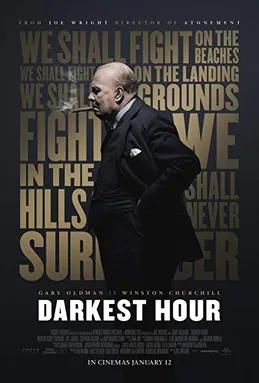Historical accuracy of Darkest Hour

Historical accuracy of Darkest Hour

Characters
Winston Churchill
Churchill was the Prime Minister during this period. The portrayal captures his determination, speaking style, and some eccentricities, though perhaps exaggerates certain traits for dramatic effect.
Clementine Churchill
Clementine was Churchill's wife and known confidante. The film portrays her supportive role and awareness of the political pressures he faced, which aligns with historical accounts.
Viscount Halifax
Halifax was Foreign Secretary and a key figure favouring exploring peace terms with Germany via Italy. The film accurately depicts his stance and political rivalry with Churchill during May 1940.
Neville Chamberlain
Chamberlain, recently replaced by Churchill, served in the War Cabinet. The film shows his waning influence and declining health, reflecting his historical situation at the time.
King George VI
King George VI did initially have reservations about Churchill but came to strongly support his resolve against negotiating. The film accurately portrays this evolving relationship.
Elizabeth Layton
Elizabeth Layton was a real secretary to Churchill, but she began working for him in May 1941, not May 1940. The character serves as a composite/representative figure for this period, and her specific interactions are largely fictionalized.
More characters
Anthony Eden
Eden was Secretary of State for War and generally supportive of Churchill's stance against negotiation during the May crisis. His portrayal is consistent with his historical role.
Clement Attlee
Attlee, leader of the Labour Party, joined the War Cabinet and supported Churchill. His brief appearances reflect his position.
Arthur Greenwood
Greenwood also joined the War Cabinet representing Labour and supported the coalition government under Churchill.
General Ismay
Hastings Ismay served as Churchill's chief military assistant and was a key figure in the military aspects of governance during this period.
Story
Churchill becomes Prime Minister (May 10, 1940)
Churchill replaced Neville Chamberlain as Prime Minister on the very day Germany invaded France and the Low Countries.
War Cabinet debates negotiating with Hitler
Intense debates occurred in the War Cabinet between May 26-28, 1940, with Halifax pushing strongly to explore peace terms offered via Mussolini, which Churchill fiercely resisted.
Halifax's push for exploring peace terms
Lord Halifax genuinely believed it was prudent to explore what terms might be available, fearing Britain's destruction if France collapsed entirely.
Churchill's staunch refusal to negotiate
Churchill was resolutely against any negotiation with Hitler, believing it would be disastrous for British morale and sovereignty.
King George VI's initial doubts about Churchill
The King initially preferred Halifax for PM and had reservations about Churchill's judgment and temperament.
King George VI visits Churchill to offer support
While the King did come to strongly support Churchill's resolve, the specific intimate meeting depicted where the King essentially tells Churchill to fight on is likely a dramatization of their developing relationship.
Churchill takes the London Underground
The scene where Churchill takes the Tube and consults ordinary citizens is entirely fictional; there is no record of this happening. It serves as a dramatic device to show him connecting with the public will.
Delivery of famous speeches ("Blood, toil...")
The film incorporates lines from Churchill's actual speeches delivered in Parliament during May and early June 1940, including his first speech as PM and the "fight on the beaches" speech.
Political maneuvering by Halifax/Chamberlain
Halifax and Chamberlain certainly discussed the political situation and Halifax considered the possibility of taking over if Churchill faltered, but the film may dramatize the extent of active plotting.
Churchill rallies Outer Cabinet/Parliament
Facing division in the War Cabinet, Churchill appealed to the wider Outer Cabinet and ultimately Parliament, securing crucial support for his policy of no surrender.
Context of Dunkirk evacuation (Operation Dynamo)
The dire situation of the British Expeditionary Force trapped at Dunkirk formed the crucial backdrop and impetus for the War Cabinet debates on negotiation.
Churchill's drinking habits shown
Churchill was known to drink consistently throughout the day (whisky, champagne, brandy), but the film might emphasize this for characterization.
Secretary Layton's specific contributions/role
As Layton wasn't working for Churchill in May 1940, her specific interactions, emotional exchanges, and influence depicted during the crisis are fictional narrative elements.
Setting
Time Period Focus (May 1940)
The film accurately concentrates on the critical few weeks in May 1940 when Churchill became PM and faced the potential collapse of France and the Dunkirk crisis.
Locations (Downing St, War Rooms, Parliament)
Key locations central to the British government and war effort are recreated with attention to detail, providing an authentic backdrop.
Churchill War Rooms recreation
The underground bunker complex is meticulously recreated, reflecting the claustrophobic and intense atmosphere where crucial decisions were made.
Costumes and Period Details
Clothing, uniforms, vehicles, and props generally appear accurate for Britain in 1940, contributing to the film's immersive quality.
Atmosphere of National Crisis
The film effectively captures the immense tension, uncertainty, and fear gripping Britain as invasion seemed imminent and the war situation deteriorated rapidly in France.
Political Climate (Appeasement vs Resistance)
The film accurately portrays the significant political division within the Conservative party and the government regarding the wisdom of fighting on versus seeking terms.
Depiction of pre-Blitz London
The film shows London under threat but before the heavy bombing campaigns began later in 1940, reflecting the specific atmosphere of May that year.
